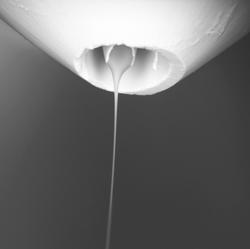"Science" lists first protein structure from an X-ray laser among top ten achievements in 2012
First new biological structure solved by a free-electron laser
Water jet carrying millions of cathepsin B microcrystals through the X-ray laser beam. The jet is about 4 microns thin (Image courtesy of Karol Nass, CFEL).
The high profile scientific journal "Science" has chosen the first new biological structure solved by an X-ray free-electron laser as one of the ten most important scientific breakthroughs in 2012. "The advance demonstrates the potential of X-ray lasers to decipher proteins that conventional X-ray sources cannot", the journal states in a press release issued on Thursday. Last month, a team of scientists from Germany and the U.S. had revealed the structure of the inactive form of an enzyme that is key for the survival of the single-celled parasite that causes African sleeping sickness, Trypanosoma brucei. The findings provide a blueprint for a possible molecular plug that can selectively block the enzyme, thereby killing the parasite.
The researchers led by the Director of the Coherent Imaging Division Prof. Henry Chapman from the Center of Free-Electron Laser Science (CFEL), Prof. Christian Betzel from the University of Hamburg and Dr. Lars Redecke from the joint Junior Research Group "Structural Infection Biology using new Radiation Sources (SIAS)" of the Universities of Hamburg and Lübeck had used the world's most powerful X-ray laser, the Linac Coherent Light Source (LCLS) at the U.S. National Accelerator Laboratory SLAC, to investigate tiny microcrystals of the enzyme. "This is the first new biological structure solved with a free-electron laser based on our serial femtosecond crystallography method," said Chapman.
X-ray free-electron lasers (XFELs) are relatively new scientific tools. DESY is the main shareholder of the European XFEL currently under construction in Hamburg. Shining about a billion times brighter than any other X-ray source, XFELs have pushed the concept of X-ray crystallography beyond its previously understood limits. "While the full potential of free-electron lasers has yet to be explored, we're already beginning to see their merits," explained Chapman. "Avoiding radiation damage, working at room temperature, and only needing microscopic crystals will have a huge impact on structural biology."
The current limitations of the new technique are due to the inefficient consumption of sample and limited beamtime. "These are both engineering issues that can be solved, and the 27,000 pulses per second at the European XFEL will go a long way in addressing both these concerns," said Chapman. "In the long run I think that we will see dedicated facilities for structural studies." This will enable science to carry out detailed studies of the dynamics of proteins and their interactions.
